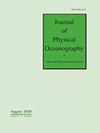准地养耦合模型中洋流反馈的热力学效应
IF 2.8
2区 地球科学
Q1 OCEANOGRAPHY
引用次数: 0
摘要
海气通量是海洋环流的主要驱动力,但仅在海洋模式中表示海气通量仍然具有挑战性。尽管只考虑大气状态的零阶表述已被广泛采用,但表层洋流反馈在过去几十年中越来越受到关注。在本文中,我们重点研究表层洋流的热力学间接反馈,它完成了由机械反馈引起的 "涡杀 "效应。在这项研究中,我们在理想化的耦合准地转模拟中,通过风应力公式的敏感性实验,量化了机械和热力学的贡献。与影响动能水平的涡流杀伤相比,间接热力学反馈会引起势能水平的显著变化。热力学反馈还使相对风应力公式引起的势能-动能湍流能量转换提高了 27%,并使势能(PE)的正向和逆向级联发生了显著变化。也就是说,在计算风应力时考虑海面洋流会显著改变从平均流到湍流的势能转移。这些变化主要是由减少的上尺度能量通量而不是更强的下尺度通量控制的,这一过程与涡杀效应相关的动能通量的结果一致。本文章由计算机程序翻译,如有差异,请以英文原文为准。
Thermodynamical effects of ocean current feedback in a quasi-geostrophic coupled model
Air-sea fluxes are the main drivers of ocean circulation, yet their representation in ocean only models remains challenging. While a zeroth-order formulation accounting only for the state of the atmosphere is well adopted by the community, surface ocean feedback has gained attention over the last decades. In this paper, we focus on thermodynamical indirect feedback of surface ocean currents, which completes the ’eddy killing’ effect induced by the mechanical feedback. In this study, we quantify both the mechanical and thermodynamical contributions in the context of idealized, coupled Quasi-Geostrophic simulations through sensitivity experiments on wind stress formulation. As compared to eddy killing which impacts kinetic energy levels, the indirect thermodynamical feedback induces significant changes in potential energy levels. The thermodynamical feedback also enhances by +27% the potential-to-kinetic turbulent energy conversion induced by relative wind stress formulation, as well as significant changes in both forward and inverse cascades of Potential Energy (PE). That is, accounting for ocean surface currents in the computation of wind stress significantly changes transfers of PE from the mean to the turbulent flow. These changes are mostly controlled by a reduced upscale energy flux rather than a more vigorous downscale flux, a process in line with results obtained for kinetic energy fluxes associated with the eddy killing effect.
求助全文
通过发布文献求助,成功后即可免费获取论文全文。
去求助
来源期刊
CiteScore
2.40
自引率
20.00%
发文量
200
审稿时长
4.5 months
期刊介绍:
The Journal of Physical Oceanography (JPO) (ISSN: 0022-3670; eISSN: 1520-0485) publishes research related to the physics of the ocean and to processes operating at its boundaries. Observational, theoretical, and modeling studies are all welcome, especially those that focus on elucidating specific physical processes. Papers that investigate interactions with other components of the Earth system (e.g., ocean–atmosphere, physical–biological, and physical–chemical interactions) as well as studies of other fluid systems (e.g., lakes and laboratory tanks) are also invited, as long as their focus is on understanding the ocean or its role in the Earth system.

 求助内容:
求助内容: 应助结果提醒方式:
应助结果提醒方式:


